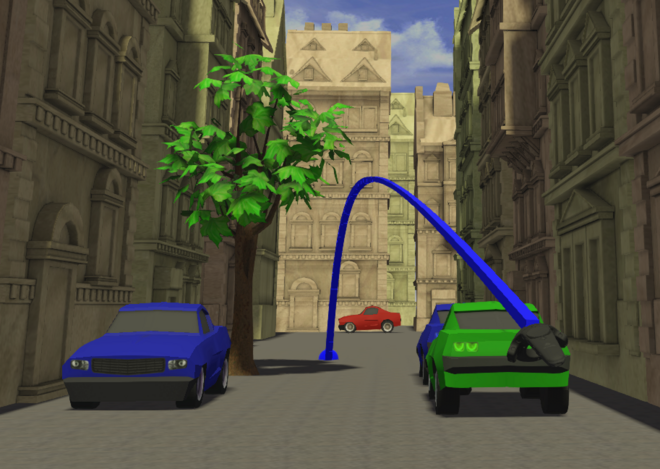During steering, the user continuously perceives the scene along the path to the destination. When teleporting, the scene is viewed from two distinct points only. The jumping metaphor is located in between since multiple jumps to a distant destination are necessary, but the path towards each individual jumping target can be seen from the previous one.
Abstract
Many recent head-mounted display applications and games implement a range-restricted variant of teleportation for exploring virtual environments. This travel metaphor referred to as jumping only allows to teleport to locations in the currently visible part of the scene. In this paper, we present a formal description and classification scheme for teleportation techniques and its application to the classification of jumping. Furthermore, we present the results of a user study (N = 24) that compared jumping to the more conventional steering with respect to spatial updating and simulator sickness. Our results show that despite significantly faster travel times during jumping, a majority of participants (75%) achieved similar spatial updating accuracy in both conditions (mean difference 0.02°, SD = 5.05°). In addition, jumping induced significantly less simulator sickness, which altogether justifies it as an alternative to steering for the exploration of immersive virtual environments. However, application developers should be aware that spatial updating during jumping may be impaired for individuals.
Our research has received funding from the German Federal Ministry of Education and Research (BMBF) under grant 031PT704X (project Big Data Analytics) and grant 03PSIPT5A (project Provenance Analytics). We thank the participants of our study as well as the members and students of the Virtual Reality and Visualization Research Group at Bauhaus-Universität Weimar.
City Generator
This tool (written in Python) generates a virtual city along a three-sement route and was used for the user study in the paper "Spatial Updating and Simulator Sickness during Steering and Jumping in Immersive Virtual Environments". The generator outputs a list of transformation matrices, which can be adjusted for and applied to any house model to allow for easy reproduction of our user study setup.
[download]
Publication
Tim Weissker, André Kunert, Bernd Froehlich, and Alexander Kulik. 2018.
Spatial Updating and Simulator Sickness during Steering and
Jumping in Immersive Virtual Environments.
In 2018 IEEE Conference on Virtual Reality and 3D User Interfaces (VR), pp. 97-104, Reutlingen, Germany, 2018. IEEE Computer Society. DOI: 10.1109/VR.2018.8446620
[IEEE][preprint][video]

